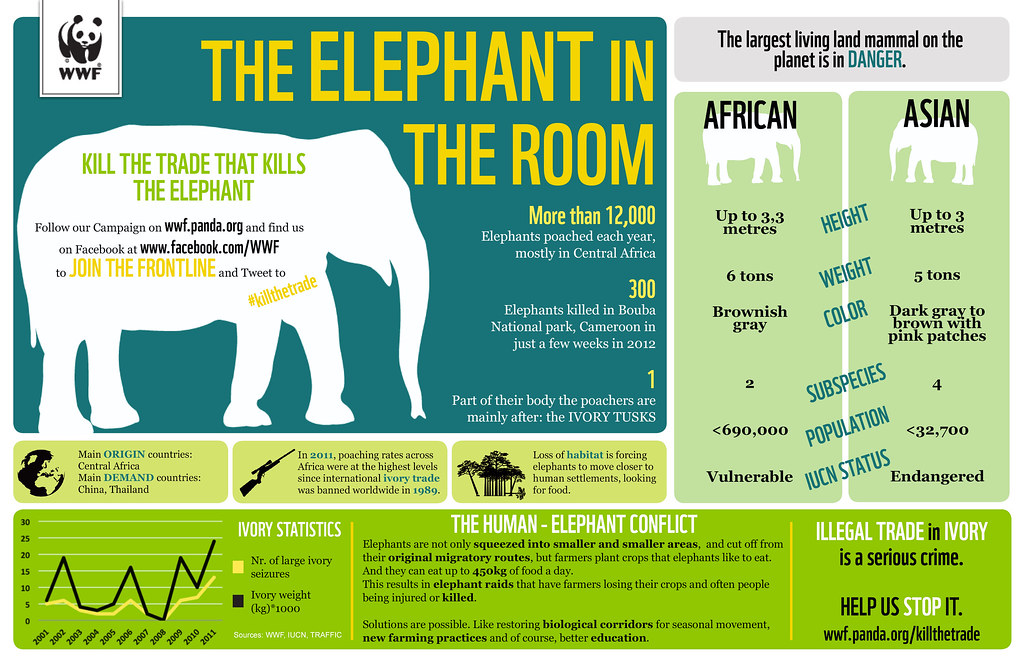The African Elephants are officially a step closer to extinction, according to the International Union for Conservation of Nature’s updated “Red List” for threatened species. Until recently, the African Elephant was classified as “Vulnerable”. This means recent findings suggest that the species now face an even higher risk of extinction in the wild. Now the species has been clubbed as two seperate species as the African Forest Elephants and African Bush Elephants. This is a major concern as elephants are ecosystem engineers. From seed dispersal, to soil regulation and habitat maintenance, numerous smaller species are dependent on elephants. Additionally, elephant dung has proven to be a sustainable alternative to many products, ranging from coffee to paper!
Contrary to popular belief, there are three species of elephants, with two species found in Africa and one in Asia. It is only recently that the conservation status of the two African species have started being evaluated separately. The African Forest Elephant, which has lost nearly 86% of its population in three decades, has been classified as “Critically Endangered.” Meanwhile the African Bush Elephant, after a 60% reduction in wild populations in 50 years, has been classified as “Endangered”.
What is the difference between the two species of African Elephants?
Standing at a maximum height of 10 feet, African Forest Elephant is the smaller of the two. Found in the rainforests of Western and Central Africa, the species has oval shaped ears, straight tusks and darker skin. Herd sizes are relatively small with males being predominantly solitary. The species are largely browsers, feeding on the leaves of the rainforest fauna.
Contrastingly, their larger counterparts, the African Bush elephants, are found predominantly in Sub-Saharan Africa. They are grazers and feed on various species of savannah grasses. These elephants have outward curving tusks and form significantly larger herds of up to 14 individuals, sometimes more.

African Elephants diverged 2 million years ago!
The two species were first classified as subspecies of the African Elephant. However, since the early 21st Century, this line of thought has changed. Studies suggest that the two species have genetically diverged at least 1.9 million years ago even though it was not until recently that both species were treated as taxonomically different.
Nonetheless, the independent assessment of the populations of both species has been well received by conservationists across the world. It is believed both species face significantly different challenges and their conservation requires completely different pathways. Furthermore, it is believed that the Forest Elephants will finally receive the support it has been lacking in the previous few decades. The species is generally fairly elusive and hence has received far less bureaucratic and monetary attention than their larger counterparts. It is believed that the species is heavily understudied. Regardless, the classification of the two species as “Endangered” and “Critically Endangered”, instead of “Vulnerable” in itself will encourage far greater conservational support by NGOs and governments alike.
Both species still face severe threats as poaching and habitat degradation is still prevalent. Fortunately, there seems to be a massive decline in ivory trade with countries such as the US, UK and China banning the domestic trade of the “White Gold”. In fact, the ban of ivory trade in China, the largest market for illegal wildlife trade, in 2017 has renewed hope for the survival of the world’s largest mammalian. However, illegal smuggling still remains a concern and ivory trade in countries such as Japan continues to thrive. It is not until poaching is entirely eradicated that the population of Africa’s elephants can revive.
Asian Elephant Populations Holding On!
On the other hand, the Asiatic Elephant, the smallest of the three, seems to be faring marginally better. Despite a 10% decrease in elephant population in India between 2010 and 2017, numerous states seem to have noted a reversal trend. Uttarakhand observed a 30% increase in elephant population between 2015 and 2020. Similar trends were noted in Karnataka and Tamil Nadu. However, the species is still considered “Endangered”. Habitat fragmentation clouds the future of the species.
Conflict with humans is also imminent despite major restrictions, with wild elephants still finding themselves captured in the cruel tourism industry, particularly in Thailand and Kerala. Furthermore, in recent years, the ivory trade hotspots have shifted from Africa to South East Asia. China’s porous borders with countries such as Myanmar, Bhutan, Nepal and India, have proven to be a massive route for illegal wildlife trade. Despite the challenges, the Asiatic Elephant, alongside an abundance of species including the Bengal Tiger, Asiatic Lion, and Indian Rhinos, have all staged big recoveries in the world’s most populated region. Such glamorous success augurs well and we hope that the two African Elephant species can stage a similar comeback.
Help us Help Them! Think Wildlife Foundation is a non profit organization with various conservation initiatives. Our most prominent campaign is our Caring for Pari intiative. Pari is a rehabilitated elephant at the Wildlife SoS Hospital. 25% of the profits from our store are donated to the elephant hospital for Pari. Other than buying our wonderful merchandise, you could donate directly to our Caring For Pari fundraiser.
